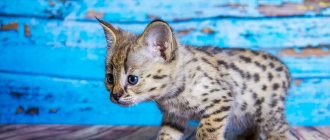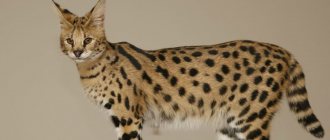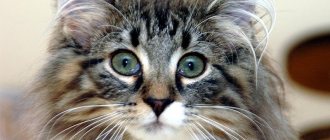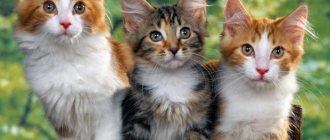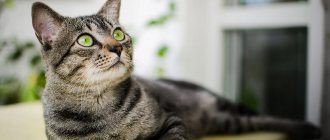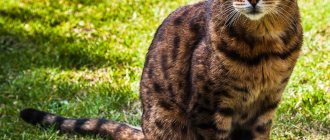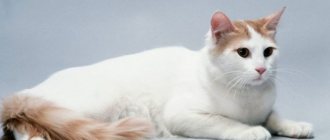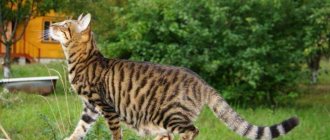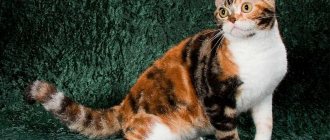Breed standards
| Breed name: | Savannah |
| Alternative title: | Savannah |
| Country of origin: | USA |
| Breed size: | Large |
| Breed group: | Long-legged |
| Average weight: | Cat: up to 14 kg Cat: up to 9 kg |
| Color standards: | Silver tabby Chocolate tabby Golden tabby |
| Coat type: | Shorthair Smoothhair |
| Character and personality: | Unpredictable Wild Smart Intelligent Curious Independent |
| Lifespan: | 17 – 20 years |
| TICA standards: |
Breed characteristics
| Activity and energy: | Read more Requires constant physical and mental stress |
| Ease of care: | Read more Savannah is independent and takes good care of its coat and hygiene. The owner’s task is to monitor the cat’s health |
| Child Friendly: | Read more Gets along well and loves to play with children. However, this is not a breed that should be recommended to families with children. Still, the Savannah is a wild cat than a domestic cat (especially F1) |
| Friendliness to other animals: | Read more Gets along well with all pets if taught to live together from an early age |
| Shedding level: | More details Minimum |
| Meow: | Savannah does not bother her owners with her meowing for no reason |
History of the Savannah cat breed
Savannah The
Savannah cat owes its origin to breeder Judy Frank. It was he who, in the mid-1980s (according to some sources in 1986), crossed an African serval and a domestic cat.
The result of this crossing is the Savannah breed. The cat got its name in honor of the grassy African savannas, where the ancestors of the African serval were also born.
- In 2001, the International Cat Association (TICA) officially registered this type of breed.
- In 2006, the Savannah entered the Guinness World Record as the tallest domestic cat in the world.
The popularity of the breed is only gaining momentum and there is not much information on the Savannah on the RuNet. In preparing this material, I relied on foreign information resources of breeders. Demand and interest in this breed has tripled from 2021 to 2021. We can conclude: the peak of the breed’s popularity is yet to come.
Savannah cat: a little about selection
The history of the creation of this breed is very interesting and unusual: for example, one of the reasons for its breeding was the desire to create a large domestic cat, not inferior in beauty to large wild cats, but much more peaceful than these predators.
The first litter was obtained from the crossing of a serval and a Siamese cat in April 1986 (USA). All the kittens were purchased by Patrick Kelly, who began closely developing the new breed. Having convinced serval breeders of the prospects of this direction, he crossed their pets with Siamese, Bengal and Oriental cats, as well as cats of the Egyptian Mau breed.
Sustainable results were obtained 10 years later - it was then that an application was submitted to the International Cat Association (TICA). In 2010, the Savannah cat breed was officially recognized.
Despite the very high cost (Savannah cats are the most expensive cats in the world), these animals immediately arose in serious demand not only in America, but also in Europe and Asia. Russia was also no exception. The popularity of such cats among our compatriots is beginning to gain momentum and there are more and more people wanting to buy a Savannah in Moscow.
They captivate people with their exotic beauty, unique and vibrant character, inexhaustible energy and deep affection for the owner. Moreover, in the last year there has been an increased demand for black Savannahs.
Description of the Savannah cat
Savannah F1
The first thing you will come across when you start looking for information about savannahs is that they are almost always described with some number F1, F2, F3, F4, etc.
Felinologists, these are specialists involved in the study and breeding of cat breeds, have developed three conventional levels of offspring - F1, F2, F3. Let's figure out what they mean and what are the differences:
- Savannah F1: the most expensive and purebred offspring obtained from crossing a serval with a domestic cat. First hybrid generation, serval and domestic cat genes 50/50 percent.
- Savannah F2: The second hybrid generation, in this case resulting from crossing an F1 Savannah with a domestic cat. Serval genes do not exceed 30 percent.
- Savannah F3: The third hybrid generation resulting from crossing an F2 Savannah with a domestic cat. Serval genes do not exceed 13 percent.
- Savannah F4, F5, F6, F7, F8: Felinologists and breeders (professional) recognize only the first three levels of offspring. According to some breeders, further breeding of the breed is pointless, this is where the Savannah generation ends.
Savannah kitten
Although Savannahs F4...F8 are not recognized by the international cat association, this fact does not prevent other breeders from breeding later generations of Savannahs. In this case, the choice is yours; as the serial number increases, the purebredness and genes of the breed decrease. Accordingly, the appearance is subject to change:
- The growth and body of the Savannah, as the Serval genes decrease, takes on the familiar shape of a domestic cat;
- The head only reminds of a distant purebred relative;
- The color acquires additional colors;The color acquires additional colors;
- The character and temperament of a wild cat inherent in purebred Savannahs is absent.
With the level of offspring and genetic designations of the savannah it is more or less clear. Let's start with the external description of the breed based on F1 standards:
- Size – The breed is very tall, thinner framed and longer than most domestic cats. This body structure gives the illusion of great weight. Weight depends on the pedigree and can vary from 5 kg. up to 11 kg;
- Color - the breed standard is brown, silver, smoke and black. The fur has dark round or oval spots, like cheetahs. The pigments on the wool should not merge. There are parallel pigment stripes in the area of the head and shoulder blades. Short and dense fur;
- The head is wide with rounded contours and longer relative to its width. The muzzle has a clear symmetrical triangular shape. The nose is elongated with a small chin;
- The eyes are almond-shaped with a drooping upper eyelid. The top of the eyes resembles a boomerang at an angle, so that the corner of the eyes descends along the line of the nose. Savannah's eyes are set close together - the distance between them is approximately equal to the size of the eye. The breed standard allows for different shades of brown, yellow and green eyes;
- Savannah F1 ears are high, like those of a serval. The outer base of the ears begins at or above the lower edge of the eyes. The inner base is located at the top of the crown of the head.
What do the designations F1, F2 and others mean?
When looking through advertisements for the sale of kittens, you will certainly come across them. The letter “F” stands for “Filial number”, that is, simply put, a generation; how many generations are the kittens offered for sale removed from their absolutely wild ancestor? Thus, “F1 kittens” means that their parents were a wild serval and a domestic cat (“wild” blood, respectively, 50%). Savannah F2 kittens have a Serval grandfather, F3 kittens have a great-grandfather, etc. There are many other subtleties (for example, mating a Savannah cat with a Serval), but this is a topic for another article. As you probably guessed, kittens of F1 and F2 matings are the most expensive - their cost sometimes reaches sky-high levels. In addition, F1 and F2 kittens are still (in the vast majority of cases) imported from the United States.
Savannah breed cost
Savannah breed
The price of Savannah F1 ranges from approximately 400,000 to 1,000,000 rubles. On the European market, the cost of this breed varies from $7,500 to $22,000. However, I have seen advertisements from nurseries for 200,000 thousand rubles, but in such cases I still advise you to consult professionals, since some breeders pass off third-generation Savannahs as F1 offspring. Be careful!
According to the latest data, prices for Savannah cats are as follows: Savannah males:
- F1 from $7,500 to $22,000
- F2 from $4,500 to $16,000
- F3 from $3,000 to $6,000
Savannah females:
- F1 from $6,000 to $22,000
- F2 from $4,500 to $14,000
- F3 from $3,500 to $5,500
In European and American catteries, most kittens will be sterilized before sale unless they are specifically intended for breeding. Kittens sold for breeding usually cost slightly more than those purchased solely as pets. The author of the article does not know the rules for the sale of Savannah cats in Russia, Ukraine and other CIS countries.
Why are savannas expensive?
Savannah F1
People often ask why the Savannah cat is so expensive. Understanding the breeding challenges of this breed will help you appreciate just how special your new pet is.
It often happens to breeders that it takes a lot of time and money to find cats suitable for breeding. A breeder may have to go through many females before a Serval cat recognizes a female as suitable for mating. The gestation period, which is about two weeks less than that of the Serval, is also a problem. Kittens may be born prematurely and require extra care to survive and remain healthy.
Some breeders report that premature births are common in early generations. Savannah kittens may also be too big to give birth naturally and require a C-section!
Savannah litters also tend to have a minimum survival rate of 0-3 kittens. Breeders may have spent as much as $100,000 before their first viable kitten is born and ready for a healthy life.
How much does a Savannah cat cost:
- The price in Russia ranges from 65 to 650 thousand rubles.
- The price in Ukraine is from 7 to 300 thousand hryvnia.
The cost of this hybrid animal is so high because they are difficult to breed. Since a serval is twice the size of a domestic cat, this can lead to a number of difficulties in the litter process. Future parents need to be raised together from childhood so that they get used to each other.
Currently, the Savannah is a hybrid of a serval and a mongrel, Oriental, Siamese, Bengal or Egyptian Mau cat.
The cost of savanna also greatly depends on its labeling:
- The first generation is marked as f1 - 50% Serval blood is present;
- Second generation f2 – 25% Serval blood.
And so on until the fifth generation f5. The more markings, the lower the price of the cat. Males of the first four generations are sterile, they are castrated and sold for keeping as pets, which also reduces their cost. And females are bred with cats of generation f 5.
Character and behavior of a Savannah cat
Savannah cat
Savannahs love to jump, jump, jump. Lifting towers and toys are essential for these breeds. They live to play and especially love to play in the water. Only after they are tired will they rest next to you. It's a good idea to have another cat or even a dog as a buddy for your Savannah.
Savannahs usually don't like to cuddle for too long, they prefer to be independent, and hate restrictions. But the savannah will walk with its tail and be where you are located. They don't like to be picked up or carried. The pet will also sleep in your bed...probably between you and your partner, if you have one.
The behavior and character are completely different from the usual domestic cats. F1 offspring are less predictable than F3, as their DNA is more dominated by wildcat genes.
Savannah becomes attached to a person and chooses one owner, considering him his companion and demonstrating his loyalty. Attachment can create difficulties - it is difficult to leave the savannah to other people, for example, during a vacation or business trip.
Savannah cat
Animals love to be close to people and often do not stray far from their owners. For this reason, they are forced to adapt to life indoors (apartment, house), but provided that you provide plenty of toys and entertainment.
Savannah is a very active breed of cat and craves constant attention, but this does not prevent it from coping well with loneliness while waiting for its owner. Perhaps activity and demand for attention are incompatible with raising young children at the same time.
However, they are considered an excellent pet for older children. This breed is characterized by touchiness; if the owner punishes unfairly or takes away a toy, the cat will “sulk”, however, they will not take revenge.
The Savannah is an intelligent breed and loves to learn; the cat can be taught fetch commands and taught to walk on a leash, give a paw and the command to sit. Savannah will constantly challenge and test your rules at every opportunity.
Having an F1 Savannah is a lot like having a teenager in your house...for the next twenty years. Many breeders advise that although F1 Savannahs are beautiful to look at, they are impractical for many people to own.
Savannahs at the F2 stage and beyond can retain quite the wild exotic beauty but be more manageable, making them better pets.
Savannah and Serval cats
Our nursery deals with exclusive F1 Savannahs (first generation hybrids), as well as Servals, which will be part of the wild nature in your home. The African serval is a wild cat that can be domesticated under certain conditions. Only a professional nursery can devote enough time to each kitten and apply the necessary skills and knowledge, as well as guarantee the excellent health of the kittens. The serval is an amazing animal with enchanting grace, gorgeous spotted color, and unsurpassed charisma. But before you buy an animal, you need to understand that cats of this breed require certain conditions. 1) Spacious room so that you can lead an active lifestyle. It is no coincidence that enclosures are built for them or a room is allocated. Most often, such cats are owned by people who live in country houses. 2) The domestic serval eats exclusively meat, that is, quail, chicken heads and offal. We do not use live birds or rodents so as not to provoke aggression in our social animals. 3) Until 4-5 months, the kitten needs enough attention so that it is constantly in contact with people. That is why we sell our cats after 3-4 months at reasonable prices. Before buying a serval, you should think about the purpose for which you are purchasing this luxurious animal. If you want a social and affectionate kitten that will tolerate children and delight you with its grace and gigantic size, then such animals are most often neutered at 3-4 months. But if you are interested in breeding cats, then we are always ready to help in establishing your cattery. The character of the serval has a number of features and directly depends on the conditions in which he lived. There are many animals in our nursery, as well as small children - all these factors contribute to the production of affectionate, friendly kittens. Each of them is hand-fed, so from the first days of life the kittens know a person. But it is important to understand that during puberty in an uncastrated Serval, instincts will take over, so we recommend that such kittens be neutered. If you are not ready for such responsibility, then we recommend that you take a closer look at the Savannah breed, which is better known as the Asherah. Savannah F1 is obtained from crossing a domestic cat and a wild Serval cat, resulting in kittens that have a wild appearance, but the affectionate character of a domestic cat. In addition, they all need a person so much that they do not require a particularly large space, which is why this breed is often bought for apartments.
Savannah is an elite cat breed, which is the most expensive in the world. This is due to the fact that not every Serval will breed a domestic cat, and it is recommended to breed brides up to a year, which further complicates the selection of a pair. Until the F4 generation, cats are infertile, so mating with other breeds is necessary, which introduces various modifications. Our goal is to obtain F1 savannas that are as close as possible to the serval. The world first saw cats of this breed only in the 1980s. On April 7, 1986, Judy Frank crossed a Serval cat with a Siamese cat to create Savannahs (first generation hybrids). But it was only in 1996 that Patrick Kelly and Joyce Sroufe prepared a project for consideration by TICA, where in 2001 this breed was officially recognized. Savannah looks like a small cheetah. Such a cat can reach almost half a meter at the withers and weigh up to 14 kg. Currently, this breed is winning the hearts of people all over the world, perhaps our kennel will be able to fulfill your dream.
Health and disease of the Savannah cat breed
As the breeders note, there are no health problems in this breed, with the exception of a tendency to hypertrophic cardiomyopathy (HCM).
Savannah cats with HCM have an enlarged heart, which can impair heart function and lead to sudden cardiac arrest.
Doctor
Savannah cats are not known to have any problems with general health. However, it is just as vulnerable as other cat breeds to all diseases and illnesses that affect the general cat population. You can prevent many health problems by regularly vaccinating your cat and maintaining a healthy immune system through proper diet and exercise.
Below are some health considerations before and after your beautiful kitten comes home.
Savannah sterilization
Spaying/neutering your Savannah will reduce the risk of health problems and unwanted behavior. Unless you intentionally purchased a cat for breeding, many breeders will neuter kittens prior to sale and include a veterinary fee as part of the purchase price.
Spay surgery is usually carried out between 10 and 14 weeks, and the kitten is under the care of veterinarians for a week after surgery to ensure that the kitten is fully restored to health.
Savannah males are typically neutered before they reach six months of age to avoid urine spraying in the house and territorial aggression towards other animals.
Declawing
If you want the procedure done, it will cost about $700 and should be done when the kitten is young. Veterinarians use laser equipment more frequently to help prevent bleeding and promote faster healing. Typically within two to three days. As for life expectancy, savannahs live from 15 to 20 years. It all depends on the content, food and lifestyle of your pet.
Savannah vaccination
Animal Vaccination
Some (but not all) Savannah breeders firmly believe that modified (live) vaccines can be fatal to Savannahs and that only (killed) virus vaccines should be used. Others are the complete opposite.
Opinions vary widely from breeders to breeders, and no research has been done to support any position. Many veterinarians who are not familiar with Savannahs may not be aware of this, so owners must be vigilant about protecting their new family member.
The vaccine traditionally used for Savannah kittens (FEL-O-VAX PCT) is no longer available, and some breeders have found that replacing it poses a threat to the Savannah's immune system. To boost their cats' immune systems, some breeders now use homeopathic remedies rather than vaccines.
Maintenance and care of the Savannah breed
Animal care is a must.
Ok, you've got your exotic beauty. Now, what are you going to do to keep him/her in good shape?
Caring for cats, like caring for the savannah, comes down to a few basic things:
- Diet: Although the Savannah cat does not have any breed-specific health problems. Because of heritage, some breeders insist that a certain percentage of raw food in the diet is important. So in general, offer more protein and less grains, and definitely by-products;
- Scratching post: if you have not removed the claws, it is necessary to teach the Savannah kitten to sharpen its claws to a certain place from childhood; this is an important process for this breed.
- Toys: An essential item in your home. If you want to maintain order and integrity of things and furniture, buy a lot of entertaining toys. With the right toys, your Savannah will stay fit and entertained for hours.
- Cleaning teeth and ears: the procedure is carried out depending on the degree of contamination.
- Brushing the coat: preferably once a week.
